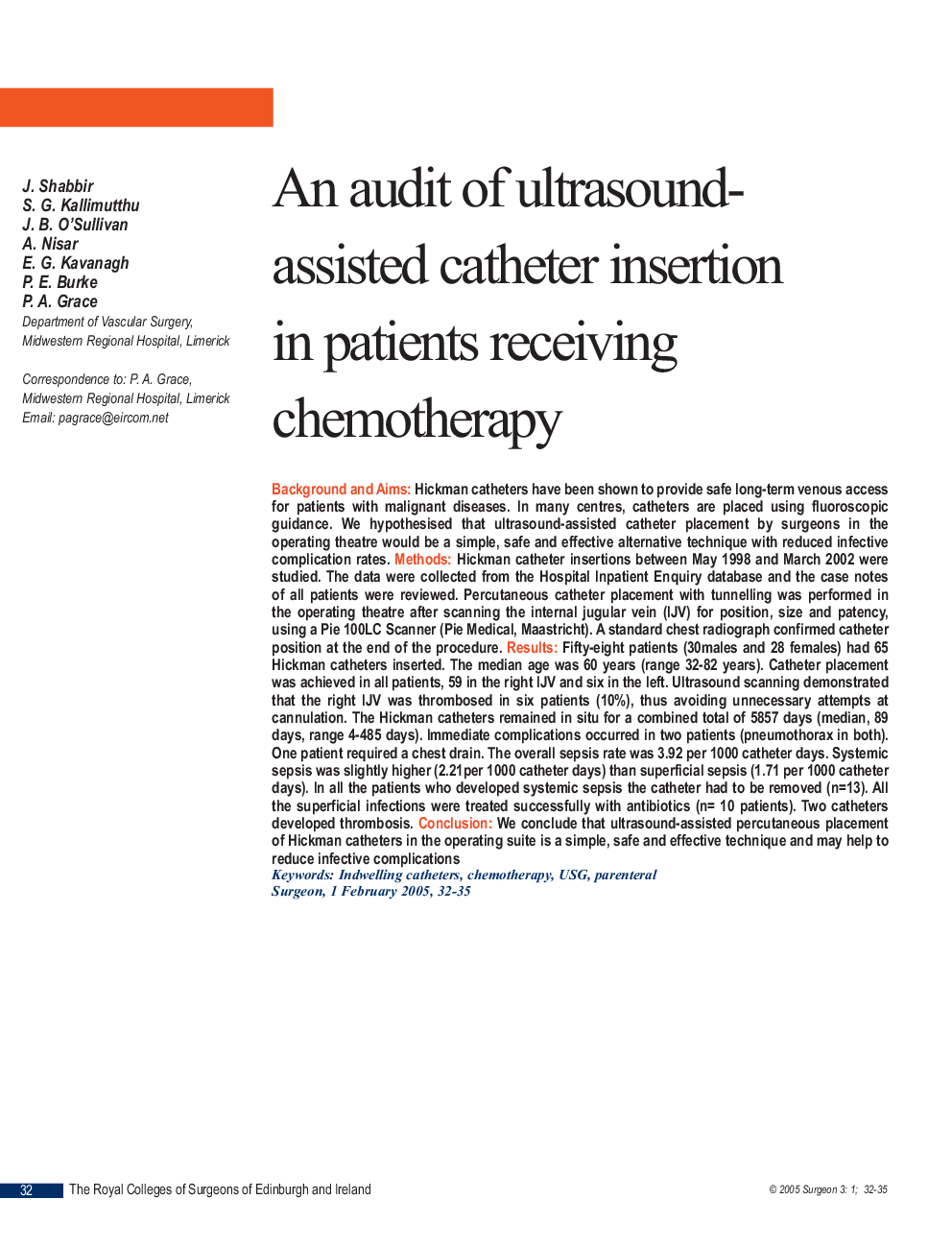| کد مقاله | کد نشریه | سال انتشار | مقاله انگلیسی | نسخه تمام متن |
|---|---|---|---|---|
| 9221801 | 1200461 | 2005 | 4 صفحه PDF | دانلود رایگان |
عنوان انگلیسی مقاله ISI
An audit of ultrasound-assisted catheter insertion in patients receiving chemotherapy
دانلود مقاله + سفارش ترجمه
دانلود مقاله ISI انگلیسی
رایگان برای ایرانیان
کلمات کلیدی
موضوعات مرتبط
علوم پزشکی و سلامت
پزشکی و دندانپزشکی
دندانپزشکی، جراحی دهان و پزشکی
پیش نمایش صفحه اول مقاله

چکیده انگلیسی
Background and Aims: Hickman catheters have been shown to provide safe long-term venous access for patients with malignant diseases. In many centres, catheters are placed using fluoroscopic guidance. We hypothesised that ultrasound-assisted catheter placement by surgeons in the operating theatre would be a simple, safe and effective alternative technique with reduced infective complication rates. Methods: Hickman catheter insertions between May 1998 and March 2002 were studied. The data were collected from the Hospital Inpatient Enquiry database and the case notes of all patients were reviewed. Percutaneous catheter placement with tunnelling was performed in the operating theatre after scanning the internal jugular vein (IJV) for position, size and patency, using a Pie 100LC Scanner (Pie Medical, Maastricht). A standard chest radiograph confirmed catheter position at the end of the procedure. Results: Fifty-eight patients (30males and 28 females) had 65 Hickman catheters inserted. The median age was 60 years (range 32-82 years). Catheter placement was achieved in all patients, 59 in the right IJV and six in the left. Ultrasound scanning demonstrated that the right IJV was thrombosed in six patients (10%), thus avoiding unnecessary attempts at cannulation. The Hickman catheters remained in situ for a combined total of 5857 days (median, 89 days, range 4-485 days). Immediate complications occurred in two patients (pneumothorax in both). One patient required a chest drain. The overall sepsis rate was 3.92 per 1000 catheter days. Systemic sepsis was slightly higher (2.21per 1000 catheter days) than superficial sepsis (1.71 per 1000 catheter days). In all the patients who developed systemic sepsis the catheter had to be removed (n=13). All the superficial infections were treated successfully with antibiotics (n= 10 patients). Two catheters developed thrombosis. Conclusion: We conclude that ultrasound-assisted percutaneous placement of Hickman catheters in the operating suite is a simple, safe and effective technique and may help to reduce infective complications
ناشر
Database: Elsevier - ScienceDirect (ساینس دایرکت)
Journal: The Surgeon - Volume 3, Issue 1, February 2005, Pages 32-35
Journal: The Surgeon - Volume 3, Issue 1, February 2005, Pages 32-35
نویسندگان
J. Shabbir, S.G. Kallimutthu, J.B. O'Sullivan, A. Nisar, E.G. Kavanagh, P.E. Burke, P.A. Grace,